1200 to 1300 AD. Bows yesterday and today cont from page 2
1208 AD - Temujin became Great Khan of the Mongols, better known as Genghis Khan.
The Mongols were expert mounted archers that used high stirrups which allowed them to shoot in any direction. They used composite bows ( 70 - 160 lb. draw weight ) and released the bowstring with a thumb ring that increased the killing range of the bow to 275 metres ( 300 yards.) The maximum range of their bows was about 550 metres ( 600 yards. )
The unarmoured soldiers wore silk under-shirts to minimise the injury from arrows. The loose silk shirt would wrap around the arrow head without being cut. This would allow the clean removal of the arrow by slowly pulling on the shirt, thus stopping cuts from barbed arrow heads and also reduce the risk of infection.
Their tactic against an opposing army would be to send in a small attack force, engage and then retreat with the opposing army giving chase. This small force would then lead the army to a pre-arranged ambush site, where the army would be surrounded by archers and showered with arrows. The heavy cavalry would then move in to finish off.
The Mongol army used ruthless tactics against cities, sometimes killing the entire population. This would spread fear through the region, making capture of further cities easier.
1211 - 1294 AD - The Mongol Empire spreads as far as Austria, Russia, Syria, Persia, Vietnam, Korea and China.
( See the TV Documentary "Storm from the East" which details the Mongol conquests.)
1227 AD - pipe rolls list a person named Robert Hood as a fugitive. ( Robin Hood ? )
1242 AD - Battle of Taillebourg - English army lost to French - 700 crossbowmen used.
1252 AD - 'Assize of Arms' - those men owning land worth between 40-100 shillings were required to equip themselves with a sword, dagger, bow and arrows. Those owning less than 40 shillings worth of land had to equip themselves with bow and arrows. All men between the age of 15 to 60 years old were ordered to equip themselves.
1298 AD - Battle of Falkirk - English army defeats Scots. The English knights charged the Scottish archers, scattering them, then the English archers attacked the remaining army
1307 AD - William Tell - because William refused to bow towards a hat placed on a pole as a sign of imperial power, has was ordered to shoot an apple off his son's head.( He was known as an expert crossbowman. ) He succeeded in shooting the apple.
The story of his feat also stated that he had a second crossbow bolt hidden behind his belt in case he failed and killed his son, he would have quickly reloaded and killed the official who had ordered him to shoot the apple off his son's head.
1333 AD - 19th July - Battle of Halidon Hill. Scottish army is defeated by Edward III of England demonstrating for the first time the full potential of the English Longbow in battle.
( 22,000 Scottish heavy cavalry defeated by 2,000 English archers and 500 knights.)
1340 AD - English ships of war had archers who used arrows with half-moon shaped heads to cut down the rigging of the opposing French ships.
1346 AD - 26th August - Battle of Crecy - Edward III of England leads his army against the French. Some accounts of the battle say that the English archers had kept their flax bowstrings dry by putting them under their helmets as it had been raining the day before.
The French force of crossbowmen attacked from the front, but maybe due to the rain, many misfired or the bowstrings snapped. The English archers showered them with arrows before they could reload. Most of the crossbowmen fled. The French cavalry then charged, but were decimated by the English archers.
1,542 French knights are killed with only 50 English killed.
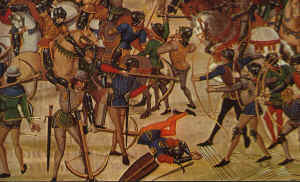 | French crossbowmen shown on the left using 'cranks' to pull the bowstring back while the English longbowmen on the right showered them with arrows. |
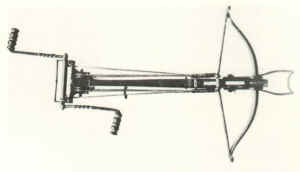 | Detail of Crossbow with Windlass. |
1356 AD - 19th September - 'Battle of Poitiers' - Edward III of England defeats King John II of France. The English troops took up positions on marshy ground near a river and when the French knights charged, they became bogged and easy targets for the English archers. King John is taken prisoner and held in the Tower of London. A ransom of 3,000,000 gold crowns is demanded for his release
1400 AD - Byzantines were defeated by Turkish archers on horses.
1440 AD -
| 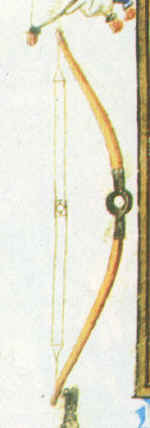
| The bow shown at left is a 'Centre Shot Stone Bow' from an painting dated about 1440 AD. It is interesting to note the split bowstring shown, as this type of bowstring/cable set-up has recently been used on the modern Compound Bows to do away with using the usual cable guard set-up. |
1415 AD - 25th October - Battle of Agincourt - Henry V of England army was attacked by the French army near Calais. Some 60,000 French soldiers faced off 6,000 English soldiers, mainly archers. The opposing forces faced each other for several hours waiting to see who would move first. Henry sounded the attack, whereby the archers advanced a short distance and planted a row of stakes in front of them. This prompted the French to attack with a cavalry charge. This charge was repelled, but the retreating force ran into the second charge of the advancing French cavalry. This caused mass confusion in the French attack.
The English archers continued to shower arrows down on the French cavalry until finally running out of arrows. The archers then attacked with swords, daggers and even mallets they had used to drive in the stakes.
Some accounts state as many as 10,000 French soldiers killed, with only 100 English soldiers killed. Other accounts state only 29 English killed.
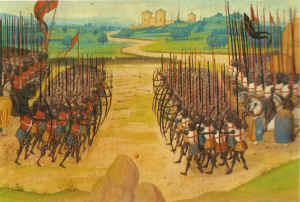 | The Battle of Agincourt showing longbowmen to the front with knights behind. |
 | Examples the various types of arrow tips used during the 15th. Century. The 'barbed' arrow tips were the most common used.
The small triangular tips without 'barbs' were used to pierce the chainmail armour.
The 'half-moon' arrow tips were used to shoot through the rigging ropes of opposing ships. |
1450 AD - Earliest surviving ballad, "Robin Hood and the Monk".
1472 AD - The practise of Archery was declining due to shortage of bowstaves.
1457 AD - James II, King of England, first decreed that the sports of football and golf should be banned as they interfered with archery practise.
1477 AD - Edward IV, King of England, bans the early version of the game of cricket as it is interfering with compulsory archery practise.
1492 AD - Leonardo da Vinci.
 | Sketch design of siege crossbow by Leonardo da Vinci, done when he was employed as a siege engineer in the court of Francis I of Fran |
1500 - 1550 AD - The ballads about Robin Hood "Lyttell Geste of Robyn Hode".
'Robin and the Knight', 'Robin, Little John and the Sheriff', 'Robin and the King' and 'Robin Hood's death'.
Maid Marion is not part of the original stories, but may have been added to later tales.
1508 AD - The use of crossbows was forbidden in England, to increase the use of the longbow.
1509 AD - Henry VIII, King of England, at age 18 proves himself an accomplished archer.
1510 AD - King Henry purchased 40,000 yew bow staves from the Doge of Venice.
1513 AD - Sept. 9th.'Battle of Flodden', fought near Branxton, Northumberland. James IV, King of Scotland, crossed the border on 22nd. August with an army of about 30,000 men supported by artillery. Thomas Howard, Earl of Surrey, gathered an army of about 20,000 to oppose him. Fearing that the Scots would retreat to the border, Surrey issued a challenge to James, who agreed to wait until September 9th. to fight. The battle began in the late afternoon. The Scots fought stubbornly, but the English 2.5 metre long bill (a staff ending in a hooked-shaped blade) proved superior to the Scottish 4.5 metre long spear and English archers proved decisive on the Scottish right. By nightfall the Scottish army was annihilated. James was killed, together with at least 10,000 of his men.
1520 AD - Henry VIII demonstrates his skill with the longbow at a summit meeting hosted by the French King, where he repeatedly shot into the centre of a target at a distance of 220 metres ( 240 yards ).
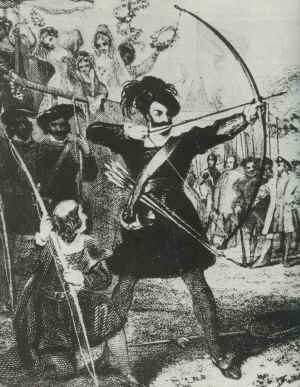 | Henry VIII demonstrating his skill with the longbow. |
1520 AD - the musket is invented and will soon replace the bow as a weapon of war.
1521 AD - General Cortes of Spain used crossbowmen in his conquest of Mexico.
1534 AD - King Henry orders that 30,000 bows be made and kept at the Tower of London.
1545 AD - King Henry's flagship "Mary Rose" sinks in the Solent near Portsmouth, England. The remains are recovered in 1982 from the fine silt that has preserved the hull and its contents. Over 100 longbows were found all made from fine-grained yew. The yew was shaped into a 'D' section with sapwood on the back of the bow and a thicker section of heartwood on the belly. This worked as an efficient natural lamination giving the bow strength. Boxes of arrows were also found, bound in bundles of 24 and kept apart with a pierced circular leather disc to prevent crushing the goose flight feathers. The shafts were 800mm long, 10mm diameter and made from ash wood. A nock was cut into the base of each shaft and reinforced with a v-shaped horn insert. It has been estimated that the range of these longbows with a 41 kg ( 90 lb. ) draw weight could have been up to 250 metres. Also other records indicate that a practised archer could shoot up to 12 arrows per minute.
( Imagine what an army of a thousand archers could do to an opposing force.
The reports of the sky darkening with arrows were a matter of fact ! )
Roger Ascham published his book 'Toxophilis' (Lover of the Bow) which was the first book written in English about archery.
1588 AD - 10,000 soldiers on the English fleet, armed with muskets, defeated the Spanish Armada. ( The decline of bow and arrow in warfare is now assured. )
1595 AD - all bows were ordered to be exchanged for muskets.
1625 AD -
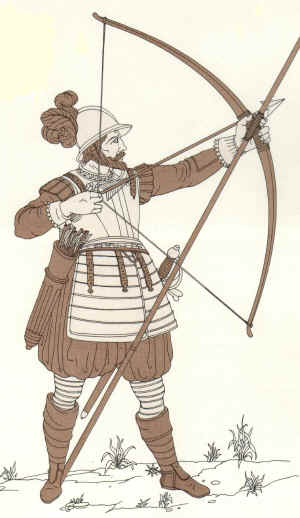 | Picture of a foot soldier about to release his longbow.
He also holds his pike at the ready to defend against possible cavalry attack.
He has a sword for close combat.
Note the two finger draw of the bowstring. |
1644 AD - Tipper Muir - last battle in which English archers were used.
1673 AD - The archery tournament known as the 'Ancient Scorton Arrow' was founded in Yorkshire, England. ( It is the oldest archery tournament still held today.)
1676 AD - The Royal Company of Archers first practised 'Clout Archery' using longbows to shoot at a 31" diameter white target at distances between 180 to 240 yards.
 Free Forum Hosting
Free Forum Hosting